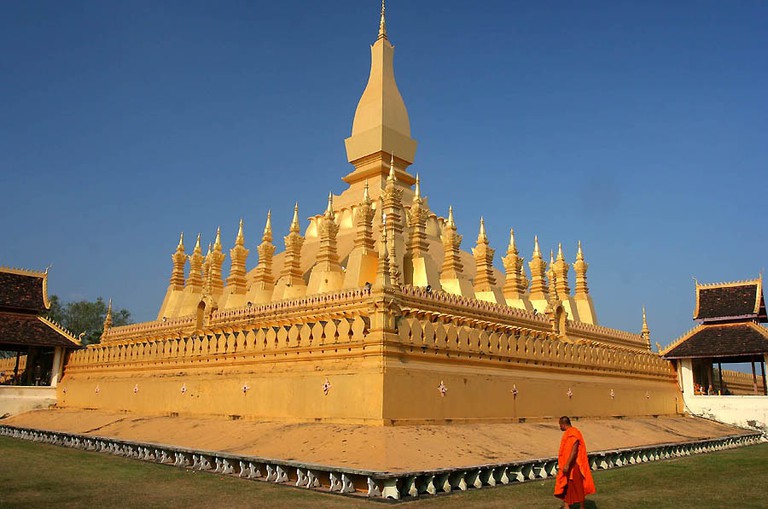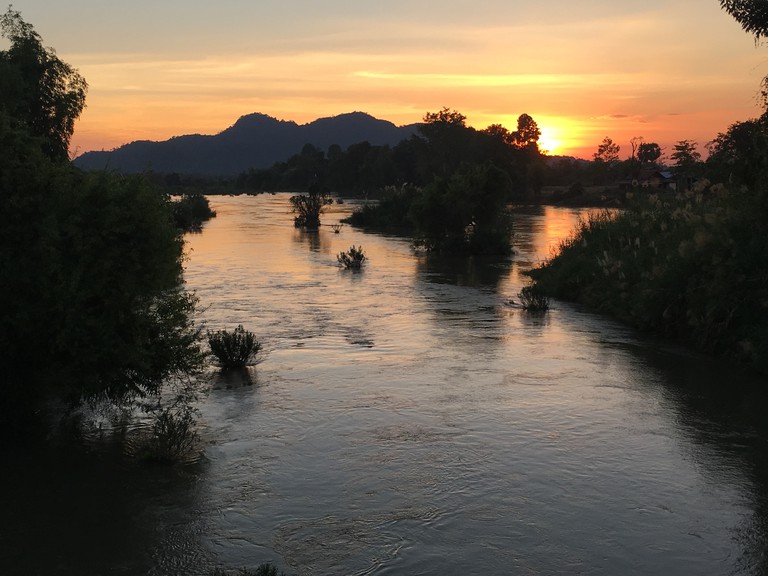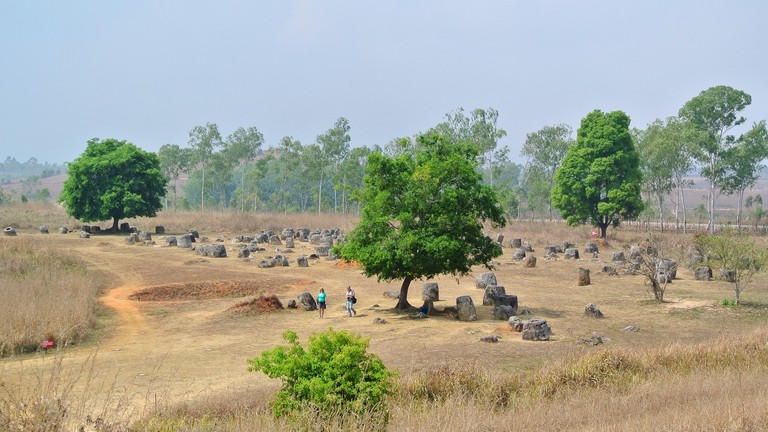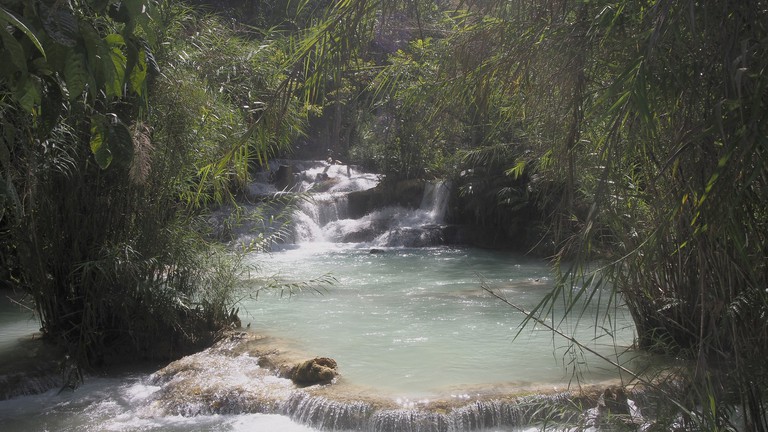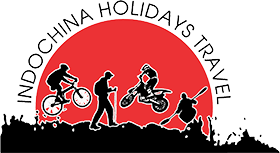Day 1: Dien Bien Phu ( Vietnam ) – Tay Trang border – Muang kua (Laos)
Pick up from Tay Trang border at around 10: 00 AM After finish immigration formalities at Vietnam immigration take a short drive to Laos immigration (5 km) and Meet Lao guide, after immigration formalities, we ride to Muangkua,( Dien Bien Phu city to Tay Trang border is 40 km )
Distance: Dien Bian to border = 30 km (From Lao immigration to hotel) 70 km
Meal: L / D
Accommodation: Sernaly hotel
Day 2: Muangkua – Udomxai
After breakfast, we head east in direction to Udomxai province, you should be feeling refreshed, although it is a gradual downhill it is up hill in some places but do not worry it is not too steep. There are some excellent photo opportunities of the friendly Khmu tribe and their families. Lunch is prepared by our guide and helpers so we can find a nice spot for lunch stop by the stream. Today is a great day riding .
Distance: 103 km
Meal: B / L / D
Accommodation: Villa keosermsack
Day 3. Udomxai – Pakmong
Today is the hard day with the big climb, continuing along Route 13 north towards Luangprabang.after 5 km from guesthouse the road starts to wind upwards and we start the first of a series of long climbs through high mountains but scenery is perfect. We are in the land of the Hmong (high Lander) who are known as originally live in high elevation in northern Laos, in former time they lived by growing opium. After long climb, we rest on the first peak for water, snacks and seasonal fruits. Then we continue the next 30 km to the second and the third peak for lunch stop, after lunch it is down, down and down as we descend 30 km into the valley, this is a last downhill. At the end of the descent, we arrive at Pakmong, a village that marks the junction at where the road turns towards Luangprabang.
Distance: 81 km
Meal: B / L / D
Accommodation: Guesthouse
Day 4: Pakmong – LuangPrabang
After breakfast we ride along Route 13 north head to LuangPrabang, today is the longest day, the road is up and down hill but no big climb, it is easy ride. At kilometer 30 to LuangPrabang we turn from road 13 on dirt road toward the Mekong River at Pak Ou village and visit Buddha caves. Optional riding or driving the last 30 km to LuangPrabang,
Distance: 110 km
Meal: B / L / D
Accommodation: Villa Phoumalin
Day 5: LuangPrabang, city tour
After breakfast cycle to visit local market (Phosi market) then cycle to visit the former royal temple of Vat Xiangthong,, Visoun temple and former royal palace (museum) also exploration of the town and afterwards, meeting with monks inside their temple to discuss their way of life, share ideas questions about their impressions of your lifestyle, beliefs, and culture and theirs.
In the afternoon, cycle outside town to visit weaving and handicrafts papers villages after that cycle back to town to climb up Phousi mount to see panoramic view of town and sunset.
- Luangprabang is the oldest city in Laos, and before the 16th century it was the capital city of the land of million elephants (Laos). The town is a beautifully preserved and in 1995 it was added to UNESCO`s World heritage list.
Ride: 15 km
Meals: B
Accommodation: Villa Phoumalin or similar
Day 6: LuangPrabang – Kewkacham
We ride out of town and join route 13 heading south. Today’s ride will take us up around 1000 meters in elevation and the climbs start almost as soon as we leave town .we ride out of the Mekong valley and into the mountains, following the Khan river. We pass many villages and stop for refreshments every 15 or 20 km. we will take the left folk staying on route 13, then start a series of tough climbs. After 15 km of climbing (1005 m above sea level), we are rewarded by a 14 km descent to Nam ming (350 m above sea level) where we will stop for lunch. After lunch, we have one last climb (20 km) into the mountains to Phou Dam before we drop down to Kew Kacham where our destination ( 1340 m above sea level ) . Accommodation is basic but dinner is good and there is plenty of Beer Lao.
Altitude: LuangPrabang = 270 m. Kewkacham = 1340 m
Distance: 78 km
Meal: B / L / D
Accommodation: Kewkacham guesthouse (primitive and share bath room, 24 h electricity)
Day 7: Kewkacham – Kasi
Our guide will prepare breakfast. This area is the coldest place in our trip especially in the morning, as we ride along the mountain ridge for 20 km. At 22 km, we start our first climb of the day for 8 km. After the big junction (the highest point on this route) where route 7 goes to the plain of jars we turn right along the Route 30 north to the restaurant with the panoramic view, 40 km from our destination Kasi, after lunch we continue down route 13, this 25 km descent is one of the best in southeast Asia, we will enjoy a most excellent after noon ride. At the bottom we have a short climb before a flat ride into a small town of Kasi where we stay overnight.
Altitude: Kewkacham = 1340 m. Kasi = 405 m
Ride: 94 km
Meal: B / L / D
Accommodation: guesthouse (good guesthouse with private bathroom and hot shower. 24 h electricity)
Day 8: Kasi – Vangvieng
We should be able to do today’s ride in a single morning leaving extra relaxation time in Vanvieng. We continue along route 13 and although there are some short climbs most of the ride is downhill or flat. The scenery is just beautiful and you should really enjoy stretching your legs. We will stop for refreshments a few times along the way, but we make a main stop after 50 km at a big village of Ban Phatang we you can take great pictures of fantastic view. The last 18 km is a fast flat ride among the spectacular limestone mountains. We will reach the hotel in time to enjoy lunch overlooking the river. The afternoon is free to explore the town or take a swim in the river. Vangvieng has a lively traveler’s scene with all the usual accompanying facilities: e-mail, pubs, pizza and many young foreigners.
Altitude: Kasi = 405 m. Vangvieng = 280 m
Distance: 55 km
Meal: B
Accommodation: elephant crossing hotel or similar
Day 9: Vangvieng – Thalat
We have a long ride today but easy ride so we will want to leave early. Riding today there are more traffic so please remember to keep riding on right side all the time. We continue along the route 13 and stop for refreshment every 20 or 25 km. The rest of the morning is along undulating roads to Hinherb village. After 69 km we reach a long bridge, we stop for lunch in a restaurant. The afternoon ride is along fast flat roads. After 83 km, we turn left at a main junction of Phonhong town. After 15 km of riding along the flat road and takes us into the town of Thalat near the NamNgum dam.
Altitude: Vangvieng = 280 m. Thalat 190 m
Distance: 100 km
Meal: B / L / D
Accommodation: GH
Day 10: Thalat – Vientiane
We ride out of Thalat pass the NamNgum dam, we have one sharp hill in the morning then it is all fairly flat, we stop for lunch in a local restaurant when we feel like it. We regroup before getting into town and then we cycle to hotel. Dinner is at KuaLao restaurant.
Altitude: Thalat = 190 m. Vientiane = 180 m
Distance: 93 km
Meal: B / L /D
Accommodation: Duangduene hotel or similar
Day 11: Departure
Transfer to the airport.
End of service

